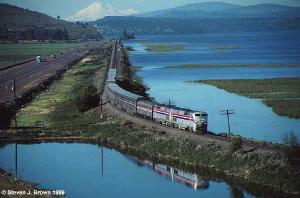Building a railroad from the Columbia River to the Sacramento was a rather lengthy process. First survey journeys were undertaken in the 1850s, but actually building the line spanned the years 1868 to 1887. The "Oregon & California Rail Road" (O&CRR) went bankrupt in the process, and the work was finished by "Southern Pacific" (SP), which survived until 1996. The 19th century passenger rail marketing of Southern Pacific christened the new line
Shasta Route.
The name was accepted and did survive until today. The reason is best explained with a picture. While the passengers of today's "Coast Starlight" might pass the Mt. Shasta sleeping, passengers in the daytime trains of the past have had plenty of opportunity to look at this mountain.

The "Coast Starlight", 2.5 hours after passing Mount Shasta.
In background: Mount Shasta.
Great views along the line was the only item to advertise. Trains needed almost 5 hours for the 81 miles from Weed to
Ashland, for an average speed of 17 miles per hour. Reason was an experiment in cost-cutting: The engineers of the SP had
changed the planned Siskiyou Mountains crossing of the O&CRR in favour of a steeper grade. Today, the 3.3 - 3.7% of the
Siskiyou crossing is considered normal for highspeed operation at 186 mph, but with the power of steam locos in the 1920s, it
was a nightmare. And even today, it is a nightmare for freight transport.
With a major investment, Southern Pacific bypassed the Siskiyou Mountains in the late 1920s. The new line, called Natron
Cutoff, was less steep, more than 20 miles shorter, and also bypassed about 2/3 of the tightest curvature between Portland
and Sacramento.
Since the population and business of Central Oregon was cut off as well, with the new line running through sparsely populated
areas, Southern Pacific kept the old line in operation for several decades.

The Shasta Route splits into the Natron Cutoff and the old Siskiyou Line.
Today, Union Pacific (UP) owns the Shasta Route, and operates an average of 19 freight trains per day via the Natron Cutoff. On the Siskiyou Line, Central Oregon & Pacific hauls up to 100 carloads per day, at linespeed restrictions of 25 mph or less. While 100 carloads is a tiny amount by railroad standards, this offers valuable relief to the parallel Interstate 5.
Today's passenger rail service on the Shasta Route is one pair of Amtraks per night, which use the Natron Cutoff. They achieve an average speed of 39 mph from Redding(CA) to Eugene(OR), if they are on time. Amtrak looses 40-50$ per train mile with its current service, depreciation of equipment not counted.